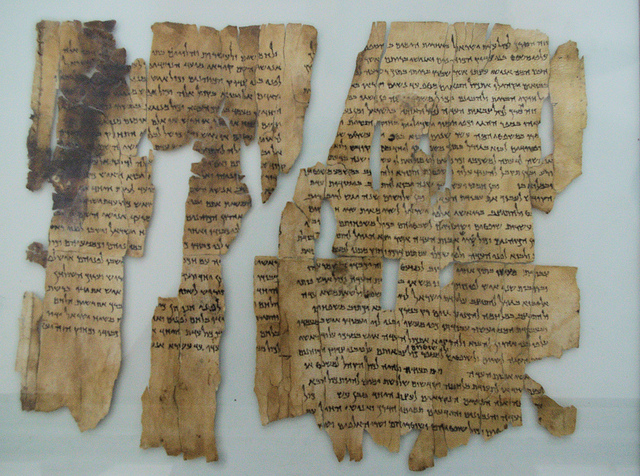By: Sherene Khouri, Ph.D. | April 23, 2023
This is an answer to our readers’ questions: Part 2 – Who were the Qumran community? Who were the Essenes?
Who were the Qumran community?
The discovery that was made on the site helped scholars to define the community that lived and copied the scrolls. Most scholars think that the people who lived in Qumran were the Essenes or Yahad movement. They were a group with a distinctive ideology from the Pharisees and the Sadducees.
Who were the Essenes?
Many scholars think that the Qumran community was Essene, who emerged from the Hasidim (Pious Ones), who at first associated with the Maccabees (1 Macc. 2:42; 7:13; 2 Macc. 14:6), a party from which the Pharisses split despite fundamental similarities but broke from them when they became more politically oriented and their high priest was usurped by one of their kings.[1]
Another theory suggests that the Essenes emerged from Jews who had returned from Babylon in the second century after they heard about the success of the Maccabean movement and the restoration of theocracy in the land. Having emigrated from Babylon, they did not find the situation in Israel as ideal as they expected. Thus, they broke with the Jerusalem priesthood, withdrew to a desert, and established their “trustworthy house in Israel.”[2]
According to Taylor, the Essenes were extremists in terms of their isolationism and withdrawal from public life. He states, “They sought a secluded retreat where they could give themselves up to undisturbed meditation. In this solitude they formed themselves into a distinct order, with strange customs and new views, and received the name of Essenes.”[3] They were more rigid than the Pharisees in relation to Sabbath rules. They also were very particular about their asceticism practices and priestly purity life. Roman historians, such as Pliny, say the Essenes near the shore of the Dead Sea were “a solitary tribe, without any women and having renounced all sexual interest.”[4] Josephus echoes Pliny, explaining:
[The Essenes] shun physical pleasure as a vice, but consider self-control and not succumbing to the passions as a virtue. And although there is among them a disdain for marriage, they adopt the children of 121 outsiders . . . Without doing away with marriage or the succession resulting from it, they protect themselves from the wanton ways of women, being convinced that none of them preserves her faithfulness to one man.[5]
There is a theory that suggests the Essenes were trying to preserve their literature from Roman persecution and they, therefore, buried their library very fast. However, a deeper study of the way of burying the jars suggests the opposite. Mirielle Bélis defines the process that the Essenes followed to bury and preserve the scrolls. She states,
(1) the texts were wound up into a tight cylinder; (2) they were fixed by a strip of leather (dozens having been found in the caves); (3) the scrolls were wrapped in different types of prepared linen; (4) they were placed in jars with this linen. This tight rolling, wrapping, binding, and jar placement together was designed for preservation, and it is to be noted that a recent study has shown that the scroll wrappers were made of the best quality white linen.
The way these scrolls were wrapped, put in jars, and preserved suggests that the community was trying to preserve their literature for a long time. Taylor, states that the Essenes lived in this location, not to practice their asceticism in the desert or to seek solitude, but rather to bury the scrolls. “The Dead Sea Scrolls are the small remnants of a huge cache of scroll burials.”[6] Taylor states, “The scrolls and Qumran are not separated from one another archaeologically; the scrolls are found within the site of Qumran… The scrolls then need to be understood archaeologically as a kind of ‘industry’ of the settlement: it was, in part, a scroll burial center [sic].”[7] The Essenes used the mineral salts of the Dead Sea to preserve and bury the scripture and to ensure they were protected for a long time.
Why the Dead Sea Scrolls are an important discovery?
The Dead Sea Scrolls authenticate the Old Testament writings. For instance, Deuteronomy 32:8 in the Masoretic Text, followed by the KJV and the ASV, reads, “The Most High gave to the nations their inheritance…. He set the bounds of the people according to the number of the children of Israel.” The RSV followed the Septuagint (LXX) rendition: “According to the number of the sons of God.” A fragment from Qumran now supports the Septuagint (LXX) reading. According to the principles of textual criticism, the RSV is correct because it is supported by the earliest known manuscript. It is in harmony with the patriarchal description of angels as “sons of God” (cf. Job 1:6; 2:1; 38:7), and explains the origin of the other variant.[8]
The Dead Sea Scrolls helped scholars gain more knowledge about the languages of Palestine/Israel that were common in the late BC and early AD. Scholars confirmed that the people of that land at that time were trilingual; they knew Greek, Aramaic, and Hebrew. The Scrolls also reveal literary activity in Aramaic and Hebrew in the period between the final redaction of the Hebrew Scriptures (165 BC) and the beginning of rabbinic literature (AD 200). “This is particularly noteworthy for Aramaic,” says Fitzmyer, “Qumran writings now clearly manifest considerable Aramaic literary creativity: Genesis Apocryphon, Enochic literature, Targum of Job, and other texts of lesser moment.”[9] This piece of information gives another attestation to the Old Testament because part of it was written in Aramaic.
The Dead Sea Scrolls contributed to the scholarly knowledge of the different Jewish sects that lived during that time of history. The scrolls revealed information about the sect who lived in the Qumran community (the Essenes)—their type of life, theology, mode of biblical interpretation, and ascetic communal life. They also support the account of Josephus about the different sects among the Jews and the pluriformity of Judaism in his day.[10]
In conclusion, the Dead Sea Scrolls reveal important information about the history of the Jews, particularly the Essene sect, and their faithful transmission of the Old Testament. They attest to the faithfulness of the scribes who copied the biblical text over the centuries because they are considered the most ancient manuscripts scholars have ever excavated. They show that the standard Hebrew Text (called the Masoretic Text) has been well preserved. However, there were other versions, slightly different from the standard version, but agree with the Septuagint (the Greek translation of the Old Testament). Their value for Christians today is immense because they help us understand more clearly issues surrounding the interpretation of the Law of Moses.
About the Author
Sherene Khouri was born into a religiously diverse family in Damascus, Syria. She became a believer when she was 11 years old. Sherene and her husband were missionaries in Saudi Arabia. Their house was open for meetings, and they were involved with the locals until the government knew about their ministry and gave them three days’ notice to leave the country. In 2006, they went back to Syria and started serving the Lord with RZIM International ministry. They traveled around the Middle Eastern region—Turkey, Jordan, Egypt, Lebanon, Syria, and United Arab Emirates. Sherene was also involved in her local church among the youth, young adults, and women’s ministry. In 2013, the civil war broke out in Syria. Sherene and her husband’s car was vandalized 3 times and they had to immigrate to the United States of America. In 2019, Sherene became an American citizen.
Sherene is an assistant professor at Liberty University. She teaches Arabic, Religion, and Research classes. Sherene holds a Ph.D. in Theology and Apologetics, M.A. in Christian Apologetics from Liberty University, and B.S. in Biblical Studies from Moody Bible Institute. She is also working on a Master of Theology in Global Studies at Liberty University and a M.A in Arabic and Linguistics from PennWest University.
Copyright 2023. Bellator Christi.
Notes
[1] Joan E., Taylor, The Essenes, the Scrolls, and the Dead Sea (Oxford Academic Press, 2013), 6.
[2] Joseph A. Fitzmyer, “What They Found in the Caves: Let’s Go to the Scrolls.” Commonweal, December 18, 1992. Gale In Context: Biography (accessed April 20, 2023). https://link.gale.com/apps/doc/A13251982/BIC?u=vic_liberty&sid=bookmark-BIC&xid=1594debb
[3] Taylor, The Essenes, the Scrolls, and the Dead Sea,6.
[4] Natural History 5.73.
[5] Jewish War 2.120-121.
[6] Taylor, The Essenes, the Scrolls, and the Dead Sea, 303.
[7] Ibid.
[8] Norman L. Geisler and William E. Nix, From God to Us Revised and Expanded: How We Got Our Bible (IL: Moody Publishers, 2012), 226-227.
[9] Fitzmyer, “What They Found in the Caves: Let’s Go to the Scrolls.”
[10] Ibid.





